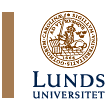

|
Panel No. 47Panel Title: Hagiographies: Topics, Canonization and InterculturalityConvenor: Johannes Beltz, Zürich, Switzerland (Südasien-Institut der Universität Heidelberg, Abteilung Klassische Indologie, Germany) Thursday 8 July, 8–12 Panel Abstract: Biographies, oral as well
as written, about eminent personalities”be they historic or
mythical”such as Muslim saints, Buddhist Bodhisattvas, Christian
martyrs, statesmen, poets, philosophers etc. seem to follow certain
common patterns. Highlighting their supreme virtues, these texts,
however, tell always more about the way people imagine these particular
persons than about the actual/historic person behind these projections.
The Christian notion of hagiography could serve as a starting point
to analyse diverse biographic narratives”religious, scientific
or secular. The panel attempts to discuss the four following points:
Papers accepted for presentation in the panel:Paper Giver 1: Andreas Doctor, Centre for Buddhist Studies, Kathmandu University, Nepal Paper title: The Multileveled Lives of Inspired Saints – Hagiography in the Tibetan Buddhist Tradition Paper abstract: Hagiographical literature in the classical Christian context is mostly restricted to an account of the religious deeds of a given saint at specific times and locations. In the case of a Mah_y_na Buddhist hagiography, however, the religious depictions of holy beings almost always presents the inspired activity of such saints as operating on several co-existing ontological levels derived with reference to an “ultimate” existence that transcends any spatio-temporal identification. The description of this higher level of being is placed by tradition within the genre of hagiography (or vimoksha – freedom tale – as it is termed in the Buddhist context) and in certain ways even given a superior position for understanding the Buddhist saint than are the subsequent detailed accounts of his or her inspired life in the world. This paper discusses the hagiographical genre within the context of these multifarious levels of religious biography and highlights the elevated status given to the account of the saint’s ultimate level of being in the Buddhist hagiographical literature. Based on a study of an early twentieth century Tibetan hagiography of the master Mchog gyur gling pa (1829-1870) the structure of a Mahayana Buddhist hagiography is presented and analyzed. It will be argued that despite the fact that the major part of a Buddhist hagiography is centered on the “historical” accomplishments of their protagonist saints such accounts remain subservient to the overarching religious reality from which the saintly figures derive their inspiration, religious authorization, and even their ontological status. Paper giver 2: Mahadevi, Karnataka State Open University, India Paper title: Hagiography and Interculturality – The Study of Saint Agastya in Karnataka’s Heritage Paper abstract: Hagiography means the writings on Saints who are glorified and exalted in the History of Religion, Myths and legends of a cultural group. Hagiography also sometimes suggests inter-culturality between different traditions as a result of mutual borrowings without conflict. Hence. Hagiography constitutes a significant source for the study of any culture. South Asia is rich in Hagiography. Among them mention may be made of Saint Agastya. He figures not only in Indian traditions and legends but also that of South-East Asia. Agastya is generally associated with Karnataka’s Heritage and particularly with the origin of the Kaveri river. Hagiography related to Agastya contains various dimensions of inter-cultural amalgamation of Dravidian and Aryan cultures. The paper tries to examine these aspects of Saint Agastya as revealed in myths, legends and Puranas, as well as some monuments established in his memory in Karnataka. Paper giver 3: Eva de Clercq, University of Ghent, Belgium Paper title: The Jain hagiographies: a preliminary study Paper abstract: According to the universal history of the Jains, some parts of the uncreated and eternal world inhabited by humans are subjected a regular sequence of movements of time, represented as a wheel. This wheel of time (kala-cakra) is divided into an upward movement (utsarpini), during which general conditions of the world change for the better, and a mirrored downward movement (avasarpini), during which they change for the worst. In every time movement, sixty-three figures are born, whose actions are considered as having a profound influence of the history of man and of the Jain dharma. These are known as the mahapurusas or salakapurusas. They are the twenty-four Tirthankaras, twelve Cakravartins and nine Baladevas, Vasudevas and Prativasudevas. The Tirthankaras, also called Jinas or Arhats, are prophets who at different moments in time, through their own holy condition, come to know and understand the ancient, eternal doctrine, and spread it among their followers. The Cakravartins, figures occurring as well in Hindu and Buddhist mythology, are monarchs ruling over the six parts of Bharatavarsa. Nine times a Baladeva, Vasudeva and Prativasudeva appear simultaneously, their lives intertwined. Well known Baladevas, Vasudevas and Prativasudevas, with better-known parallels other traditions are Rama, Laksmana and Ravana, and Balarama, Krsna and Jarasamdha. The biographies of these illustrious men are narrated in the Jain caritas (caritras) or puranas. Examples are Jinasena Punnata's Harivamsapurana, about Balarama, Krsna, Jarasamdha and the contemporary Tirthankara Aristanemi (eighth century), Paumacariyam of Vimalasuri (?fifth century) about Rama, Puspadanta's Mahapurana about all the mahapurusas, etc. Firstly this paper will give a survey of these stories. Secondly, we will examine if and to what extent these biographies can be viewed as hagiographical, and as such we will compare them to other forms of South-Asian hagiographies. Paper giver 4: Laure Singaravelou, Paris, France Paper title: Syed Ibrahim – A Muslim Saint of Tamil Nadu Paper abstract: I’ll compare the double oral narratives mainstreams which Syed Ibrahim's figure - a muslim saint whose dargah is situated in southern Tamil Nadu at Erwadi - has generated on the field. Both taking root in a written hagiography in persian, partly and freely translated in tamil in available publications aimed at pilgrims; each of them representing a distinct stake. One is promoted by a muslim academic historian; the other by the shareholders' community administering the shrine. The first one operates a shift from hagiography to historiography allowing to assess an early muslim presence in the Deccan, one century before the Madurai Sultanate mentioned by District Gazetteers; the second the reverse. Indeed, through the dargah committee, Nalla Ibrahim, the dargah's historical founder, mentioned on sasana copper plate dating back in 18th century, was inserted in the contemporary version of the hagiography of Erwadi's saint. (cf."Le saint Syed Ibrahim d'Erwadi. Eléments d'histoire hagiographique d'un sultan du Tamil Nadu", Cahiers de littérature orale, N°49, 2001.) Paper giver 5: Johannes Beltz, South Asia Institute Heidelberg, Germany Paper title: Deshabhakta Hitler: Hagiography, Mythical Leadership and Politics in modern India Paper abstract: The title of my paper might raise controversies. Should the convenor of a panel on hagiography not concentrate on “classical” religious texts, on miraculous stories of Hindu or Buddhist saints? Though not immediately visible this paper explores the construction and meaning of modern hagiographic writing. (I should add that the idea for this paper raised in my mind during my very first trip to India in 1992.) What is behind my numerous encounters with sympathizers if not explicit fans of Hitler? How to understand these people? In spite of all we know about Hitler, he is often projected as “true patriot” who sacrificed his life for his beloved desha. I was told that he never married, was vegetarian, belonged to the Aryan race and while fighting against the British colonialists used the svastika as flag. How to analyse this discourse? As a deep cultural misunderstanding? Who are the authors of this discourse? With which political/ideological movement can they be identified? From which discursive contexts do the references to vegetarianism, asceticism, and race come from? What are the topics used to imagine Hitler’s sainthood? It is evident that this highly idealized leader has very little in common with the authentic and historic person that was Hitler. In the end it should be demonstrated that the admiration of Hitler can be understood as a hagiographic text transporting a mythical thinking of its own.
SASNET - Swedish South Asian Studies Network/Lund
University
|

